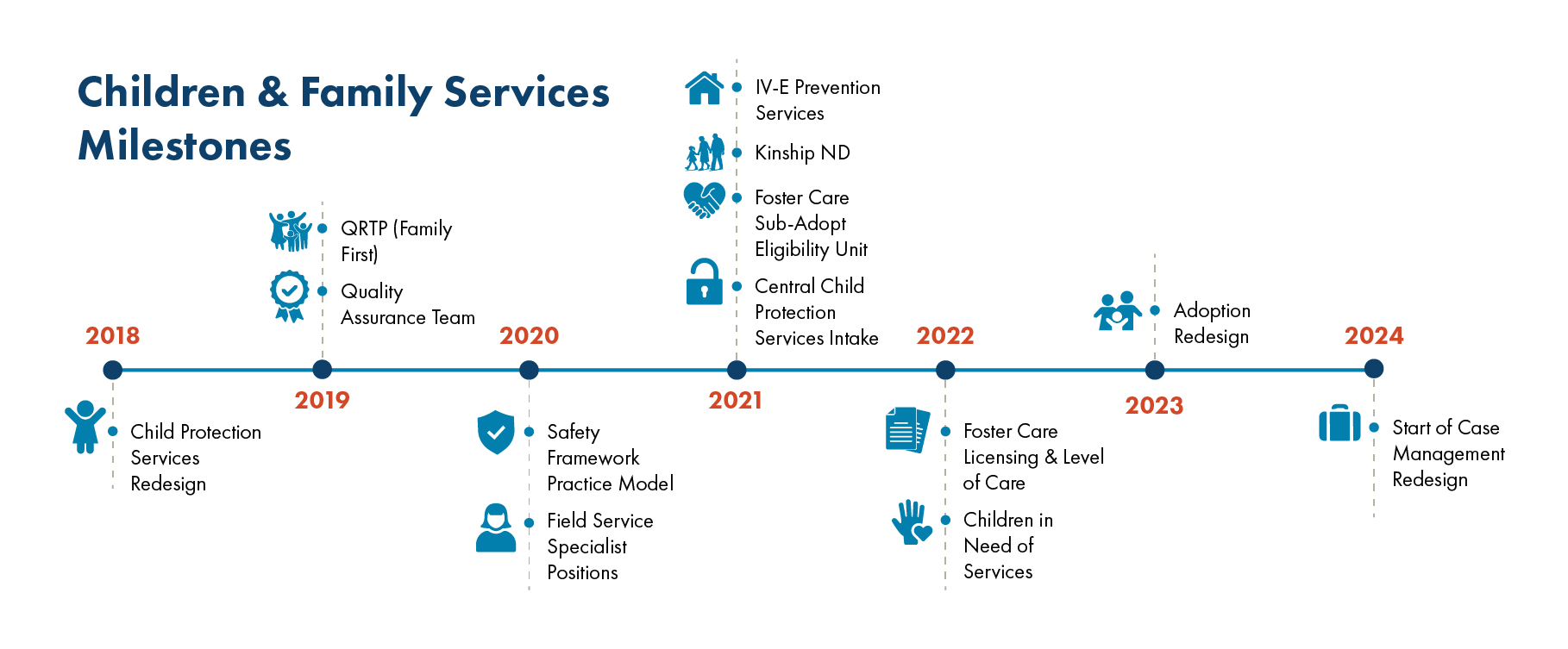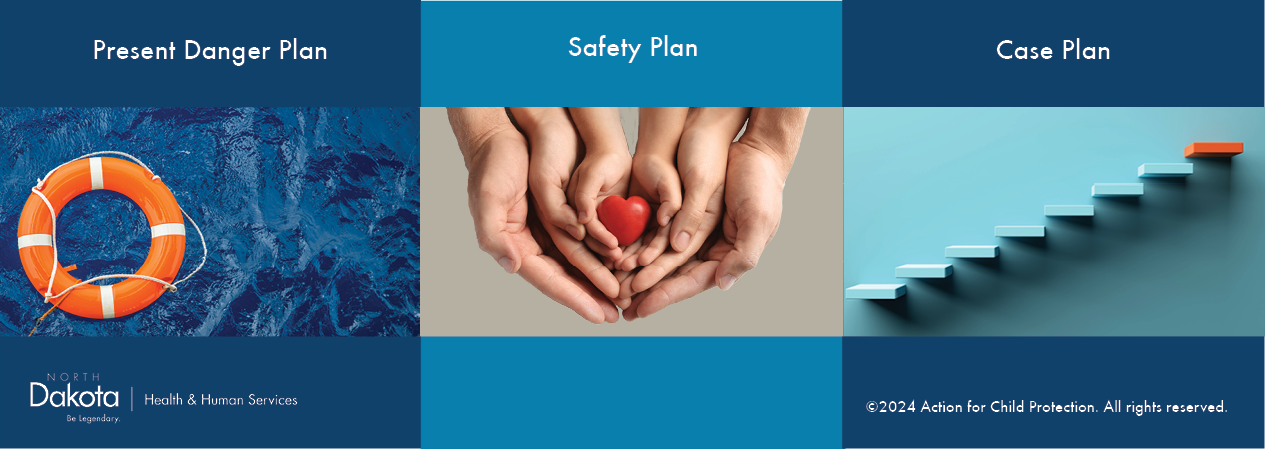
Improving how we serve North Dakota’s families and children
North Dakota has the lowest number of children in foster care in the last 10 years. This has been achieved through several milestones that Children and Family Services has achieved since 2018. The primary objective of these milestones is to improve the safety, permanency, and well-being of children and families served by HHS, North Dakota human service zones and tribal nations.
Milestones In Progress
2024 - 2025 Case Management Redesign
Purpose:
Engage, inspire and strengthen North Dakota families by providing them with opportunities and support to: 
Discover their potential to keep their children safe and their family together.
Promote family health and well-being.
To meet families where they are at in the moments that matter.
With the core purpose in mind, HHS will offer consistency and efficiencies for families, custodial agency workers, foster care providers and adoptive families, while improving how agency staff serve children and families.
Timeline:
Start: May 2024
Complete: Estimated December 2025
How it will be accomplished:
The redesign began with the creation of the Case Management Redesign Champions Team, consisting of experts from a variety of agencies. The champions team met virtually and in person to discuss eligibility standards, workflow, processes, timelines and more. Findings from the champions team were then carried over to the Case Management Redesign Team.
Like the champions team, the Case Management Redesign Team consists of representatives from various agencies. The team's role is to design a re-visioned case management process for North Dakota’s child welfare system. To achieve this, the redesign team will assess and evaluate strengths and challenges, ways to improve workflow, and how to move forward in supporting stronger outcomes for children and families.
The redesign team has identified the primary customer as the “family” (children and parents) in need of service. Redesign processes are being assessed and evaluated to ensure the primary customer is at the center of any plan, goal or decision.
| Redesign Workstream | Workstream Goal |
| Case Movement | Map out case movement from beginning to end. This workstream will take “what great looks like” and create a process that will reflect the core purpose, one program for the benefit of families. |
| Culture of Engagement | Deliver a quality, healthy engagement experience where families and workers clearly understand expectations, motivating families to discover their potential and achieve self-sufficiency without the need for ongoing agency intervention. |
| Safety Framework Practice Model Readiness | Identify ways to measure Safety Framework Practice Model (SFPM) implementation and practice across each zone and at each level. Identify barriers and solutions to help with consistent application of the SFPM across the state with the end goal that the SPFM is implemented as the foundation of our child welfare practice. |
| Connection to Support | Identify a list of supports and services that will have a high impact for our primary customer reaching their goals. The list is readily available for case workers, so it doesn’t interfere with their blue light time and can help identify supports for the primary customer, regardless of what area of the state they reside in. |
| Supervision | Supervisors will have the skills and ability to provide protected quality time with their workers to ensure case movement and progress for children and families that is in alignment with SFPM. |
Contact information:
Children and Family Services
Health and Human Services
600 E. Boulevard Ave., Dept. 325
Bismarck, ND 58503
Email: hhscfs.nd.gov
Phone: 701-328-2316
Achieved Milestones
2023 – Adoption Redesign
Purpose:
Streamline and standardize procedures for the adoption process. 
The goal of the adoption redesign was to provide a timely and safe adoption finalization with a permanent family for all children in foster care who have a permanency goal that includes adoption. The target for adoption redesign was to achieve adoption finalization within 60 days of termination of parental rights in 80% of cases. This required the effort of the entire child welfare system and an adherence to the policies and procedures of the redesign.
As a result of the redesign, new procedures and policy with an overall goal of offering efficiencies for custodial agency workers, Adults Adopting Special Kids (AASK) staff, and prospective adoptive parents were implemented.
Timeline:
Start: Aug. 1, 2023
Complete: Feb. 1, 2024
Accomplishments:
North Dakota families who are seeking to adopt from foster care now have a more simplified experience. Families should expect less paperwork, no background check processing fees, fewer home visits, fewer required personal references, an abbreviated training process for relative adopters and the foster care home study will be made available to adoption workers to supplement the adoption-specific study process.
Contact information:
Children and Family Services
Health and Human Services
600 E. Boulevard Ave., Dept. 325
Bismarck, ND 58503
Email: hhscfs@nd.gov Phone: 701-328-3580
2022 – Foster Care Licensing and Level of Care
Purpose:
Streamline processes and standardize procedures for foster care licensing.
The Children and Family Services Licensing Unit offers consistency and efficiencies for providers, custodial agency workers and licensing staff.
The Licensing Unit consists of HHS employees, located across the state completing tasks that include, but are not limited to:
Licensing or certifying eligible applicants seeking to provide foster care for children across the state.
Reviewing and licensing applications presented by an authorized agent (tribal nation, Nexus PATH, etc.).
Licensing of qualified residential treatment programs, licensed child-placing agencies, supervised independent living programs, and certified shelter care programs.
Managing respite and shelter care funds used as a prevention safety service for families across the state.
Managing a universal Children’s Treatment Services Level of Care assessment specific to children in foster care and mirrored by children in the custody of their parents/guardians in need of treatment.
Oversight of the North Dakota Recruitment and Retention State Plan.
Timeline:
Start: Oct. 1, 2021
Complete: April 1, 2022
Accomplishments:
The development of a centralized licensing unit streamlined the job responsibilities and licensing tasks formerly completed independently across North Dakota’s 53 counties (19 human service zones).
Contact information:
CFS Licensing Unit
Children and Family Services
Health and Human Services
600 E. Boulevard Ave. #325
Bismarck, ND 58503
Email: cfslicensing@nd.gov
Phone: 701-328-2322 or 1-888-334-1330
Inquiries call 1-833-FST-HOME (1-833-378-4663)
2021 – Foster Care Sub Adopt Eligibility Unit (Centralized Foster Care and Subsidized Adoption Eligibility Unit)
Purpose:
Streamline processes and standardized procedures for foster care and adoption eligibility determinations. 
The Foster Care Sub Adopt Eligibility Unit provides consistency and efficiencies for custodial agency workers, tribal nations, foster care providers and adoptive families. The unit consists of HHS employees, located across the state completing tasks that include, but are not limited to:
Determine eligibility for all children receiving prevention services as candidates for foster care.
Determine eligibility for all children who enter North Dakota foster care.
Authorize foster care payments to licensed foster care providers.
Manage the child’s account receivables (funds to be applied to the foster care costs).
Manage ND Medical Services Medicaid cases for children in foster care and under adoption subsidy.
Negotiate initial and ongoing subsidies for adoption cases.
Timeline:
Start: Aug. 1, 2020
Complete: Feb. 1, 2021
Accomplishments:
The Foster Care Sub Adopt Eligibility Unit streamlined the job responsibilities and tasks formerly completed independently across North Dakota’s 53 counties (19 zones).
Contact information:
FCSA Eligibility Unit
Children and Family Services
Health and Human Services
600 E. Boulevard Ave., Dept. 325
Bismarck, ND 58503
Email: cfsfcsaunit@nd.gov
Phone: 701-328-2076
2021 – Central Child Protection Services Intake
Purpose:
Respond to children who are maltreated, unsafe or in need of protection services in a timely manner.
The Centralized Child Abuse and Neglect Reporting line is staffed by trained professionals who specialize in child abuse and neglect. It provides a standardized Child Protection Services (CPS) intake process that streamlines reports of suspected child abuse and/or neglect to ensure the criteria in state law are met to prevent unnecessary intervention. Comprehensive intakes provide supportive information to child protection workers to assist in their response to children who are maltreated, unsafe, or in need of protection and services, in a timely manner.
Timeline:
Launched on Jan. 4, 2021
Accomplishments:
Approximately 8,831 calls were received in 2021 and over 10,600 in 2024. Positive feedback from community partners has increased and the zones continue to play an active role in working with their local agencies whenever concerns arise.
2020 – Field Service Specialist Positions
Purpose:
HHS transitioned human service zone regional representative positions to Children and Family Services field service specialist positions. Field services specialists are assigned to case management and child protective services. Case management field service specialists monitor the agency’s fidelity and quality of work related to the child welfare practice model as well as federal and state law. The field service specialists provide technical assistance, consultation, training, and mentoring during agency case staffing and child and family team meetings.
Timeline:
Launched September 2020
Accomplishments:
The transition from regional representatives to the creation of field service specialist positions allowed for dedicated staff already closely intersecting with Children and Family Services administration to work more collaboratively together as one.
2020 – Safety Framework Practice Model

Purpose:
Create a consistent child welfare practice for all human service zones by implementing the Safety Assessment and Family Evaluation Model (SAFE) (©2024 Action for Child Protection. All rights reserved) as North Dakota’s Safety Framework Practice Model (SFPM).
The SFPM uses standardized tools and decision-making criteria to make well-founded child safety decisions to ensure child welfare agencies intervene in families’ lives only when necessary. The SFPM reinforces safety planning within the home to reduce further trauma to the child. Removing children from their parents/caregivers and family home occurs only after a comprehensive assessment indicates in-home safety planning is not possible. The SFPM requires the agency to work closely with the family throughout the case planning process to create lasting changes that ensure the child's safety even after the case is closed.
Timeline:
Start: March 2019
Complete: December 2020
Accomplishments:
- 17% improvement in timely child protection services (CPS) response to reports of child maltreatment.
- 55% improvement in ensuring children are safely maintained in their homes whenever possible and appropriate.
- For children placed in foster care, 12% improvement in preserving the continuity of their family relationships and connections.
- 44% improvement in ensuring families have enhanced capacity to provide for their children’s needs.
- 28% improvement in ensuring educational needs of children are met.
- 30% improvement in ensuring children receive adequate services to meet their physical and mental health needs.
While other redesign efforts have contributed to these successes, it is notable that SFPM has had a significant impact on child welfare services in North Dakota.
Contact information:
Children and Family Services
Health and Human Services
600 E. Boulevard Ave., Dept. 325
Bismarck, ND 58503
Email: hhscfs.nd.gov
Phone: 701-328-2316
2019 – Quality Assurance Team
Purpose:
Support practice improvement and strengthen the state’s child welfare system. 
The Quality Assurance (QA) Unit was created to monitor foster care and in-home case management services provided by 19 human service zones, four tribal nations, with whom the state has a Title IV-E State-Tribal Agreement, and the Division of Juvenile Services.
A centralized dedicated team conducts ongoing QA through case record reviews to assess if the state is achieving the federal child welfare outcomes of safety, permanency and well-being. Case record reviews are a collaborative process that includes a review of the case record and a scheduled phone or video conversation with people who are closely connected to the case.
The QA Unit operates in tandem with the ongoing continuous quality improvement efforts within Children and Family Services.
Timeline:
Launched November 2019
Accomplishments:
108 cases reviewed within the first year of operation (2020).
Received federal approval in 2024 to conduct the required Federal Children and Family Services Review using the state’s case record review process. This federal review is currently underway.
Contact information:
2018 – Child Protection Services Redesign
Purpose:
Improve the services delivered to children and families, while aiming to create efficiencies across the child welfare system.
The CPS redesign centered on decreasing the time involved in completing quality CPS assessments, while assuring services to families were offered earlier to prevent further involvement in the child welfare system. Over the course of six weeks, detailed planning occurred to address best practices, analyze compliance with state and federal law, and to conduct a review of current practices to allow for a more streamlined system that focused on the quality and interactions with families to support better outcomes for the clients we serve.
The goals for redesign were to improve outcomes for families, offer quality services across the state, ensure every worker has supervisor support, standardize the work that is followed with fidelity to the model and to work collaboratively across zones. Through this collaborative effort, children’s safety would be ensured by conducting timely assessments that offer services that build supportive connections and protective factors for families to prevent child maltreatment.
Timeline:
September 2018 - Jan. 17, 2019
Accomplishments:
Strengthened collaboration between local human service zones to provide consistency in child protection intakes, assessments, referrals, and ongoing support to children and families.
